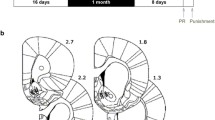Abstract
Rationale.
Maintaining abstinence is highly challenging for cocaine ex-users. Exposure to drug conditioned stimuli (CS) and to low doses of cocaine can provoke craving in humans and reinstate self-administration (SA) behavior in animal models. Whether drug- and CS-induced reinstatement depend on the same biological substrates remains controversial.
Objectives.
We investigated the relationships between cocaine- and CS-induced SA reinstatement within the same individuals as a function of the duration of the withdrawal period after cessation of extended cocaine SA.
Methods.
Sprague-Dawley rats were trained for cocaine intravenous SA (0.8 mg/kg per infusion) during 74 sessions (2 h daily exposure to cocaine) and submitted to withdrawal. Five and 30 days after the end of SA, cocaine- and CS-induced reinstatement were tested.
Results.
Both after a short and a long withdrawal, CS- and cocaine-induced reinstatement were not related. Furthermore, cocaine-induced reinstatement measured after a short and a long withdrawal was positively related while CS-induced reinstatement was not. The sensitivity of an individual to cocaine-induced reinstatement is not related to its sensitivity to CS-induced reinstatement. Furthermore, vulnerability to cocaine-induced reinstatement is determined quickly after SA cessation and is a long lasting state, whilst vulnerability to CS-induced reinstatement develops quickly or slowly depending on the individual.
Conclusions.
These results support the view that cocaine and CS induce reinstatement through different mechanisms. They imply that reinstatement in drug abuse is a heterogeneous condition with some individuals being more sensitive to one factor than to the other. Research for effective anti-relapse therapies should take these elements into account.



Similar content being viewed by others
References
Baker DA, Tran-Nguyen TL, Fuchs RA, Neisewander JL (2001) Influence of individual differences and chronic fluoxetine treatment on cocaine-seeking behavior in rats. Psychopharmacology 155:18–26
Caine SB, Lintz R, Koob GF (1993) Intravenous drug self-administration techniques in animals. In: Sahgal A (ed) Behavioural neuroscience: a practical approach. Oxford University Press, Oxford, pp 117–143
Ciccocioppo R, Sanna PP, Weiss F (2001) Cocaine-predictive stimulus induces drug-seeking behavior and neural activation in limbic brain regions after multiple months of abstinence: reversal by D(1) antagonists. Proc Natl Acad Sci USA 98:1976–1981
Cornish JL, Kalivas PW (2000) Glutamate transmission in the nucleus accumbens mediates relapse in cocaine addiction. J Neurosci 20:RC89
Cornish JL, Duffy P, Kalivas PW (1999) A role for nucleus accumbens glutamate transmission in the relapse to cocaine-seeking behavior. Neuroscience 93:1359–1367
DeJong W (1994) Relapse prevention: an emerging technology for promoting long-term drug abstinence. Int J Addict 29:681–705
Deroche V, Le Moal M, Piazza PV (1999) Cocaine self-administration increases the incentive motivational properties of the drug in rats. Eur J Neurosci 11:2731–2736
Ehrman RN, Robbins SJ, Childress AR, O'Brien CP (1992) Conditioned responses to cocaine-related stimuli in cocaine abuse patients. Psychopharmacology 107:523–529
Fuchs RA, See RE (2002) Basolateral amygdala inactivation abolishes conditioned stimulus- and heroin-induced reinstatement of extinguished heroin-seeking behavior in rats. Psychopharmacology 160:425–433
Gorelick DA (1993) Overview of pharmacologic treatment approaches for alcohol and other drug addiction. Intoxication, withdrawal, and relapse prevention. Psychiatr Clin N Am 16:141–156
Graham JH, Porrino LJ (1995) Neuroanatomical substrates of cocaine self-administration. In: Hammer RP Jr (ed) Neurobiology of cocaine. CRC Press, Boca Raton, Fla., pp 3–14
Grimm JW, See RE (2000) Dissociation of primary and secondary reward-relevant limbic nuclei in an animal model of relapse. Neuropsychopharmacology 22:473–479
Grimm JW, Hope BT, Wise RA, Shaham Y (2001) Neuroadaptation. Incubation of cocaine craving after withdrawal. Nature 412:141–142
Jaffe JH, Cascella NG, Kumor KM, Sherer MA (1989) Cocaine-induced cocaine craving. Psychopharmacology 97:59–64
Kantak KM, Black Y, Valencia E, Green-Jordan K, Eichenbaum HB (2002) Dissociable effects of lidocaine inactivation of the rostral and caudal basolateral amygdala on the maintenance and reinstatement of cocaine-seeking behavior in rats. J Neurosci 22:1126–1136
Leukefeld CG, Tims FM (1989) Relapse and recovery in drug abuse: research and practice. Int J Addict 24:189–201
McFarland K, Kalivas PW (2001) The circuitry mediating cocaine-induced reinstatement of drug-seeking behavior. J Neurosci 21:8655–8663
Meil WM, See RE (1997) Lesions of the basolateral amygdala abolish the ability of drug associated cues to reinstate responding during withdrawal from self-administered cocaine. Behav Brain Res 87:139–148
Park WK, Bari AA, Jey AR, Anderson SM, Spealman RD, Rowlett JK, Pierce RC (2002) Cocaine administered into the medial prefrontal cortex reinstates cocaine-seeking behavior by increasing AMPA receptor-mediated glutamate transmission in the nucleus accumbens. J Neurosci 22:2916–2925
See RE, Kruzich PJ, Grimm JW (2001) Dopamine, but not glutamate, receptor blockade in the basolateral amygdala attenuates conditioned reward in a rat model of relapse to cocaine-seeking behavior. Psychopharmacology 154:301–310
Shaham Y, Erb S, Stewart J (2000) Stress-induced relapse to heroin and cocaine seeking in rats: a review. Brain Res Rev 33:13–33
Shalev U, Grimm JW, Shaham Y (2002) Neurobiology of relapse to heroin and cocaine seeking: a review. Pharmacol Rev 54:1–42
Sutton MA, Karanian DA, Self DW (2000) Factors that determine a propensity for cocaine-seeking behavior during abstinence in rats. Neuropsychopharmacology 22:626–641
Tran-Nguyen LT, Fuchs RA, Coffey GP, Baker DA, O'Dell LE, Neisewander JL (1998) Time-dependent changes in cocaine-seeking behavior and extracellular dopamine levels in the amygdala during cocaine withdrawal. Neuropsychopharmacology 19:48–59
Author information
Authors and Affiliations
Corresponding author
Rights and permissions
About this article
Cite this article
Deroche-Gamonet, V., Martinez, A., Le Moal, M. et al. Relationships between individual sensitivity to CS- and cocaine-induced reinstatement in the rat. Psychopharmacology 168, 201–207 (2003). https://doi.org/10.1007/s00213-002-1306-9
Received:
Accepted:
Published:
Issue Date:
DOI: https://doi.org/10.1007/s00213-002-1306-9




